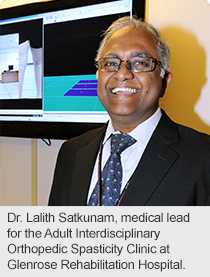
March 16, 2015
Story by Gregory Kennedy; photo by Dale MacMillan
Donna Durnford says she cannot overstate the positive impact her health care providers have had on her life.
“They completely changed my life. You can put that in big letters. That’s the sound byte,” says the 46-year-old Grande Prairie woman, whose multiple sclerosis led to muscle spasticity and a severely twisted left foot that left her unable to walk.
The mother of two is one of many Albertans with tight or stiff muscles who have regained ease of movement, more independence and improved quality of life thanks to a new specialized clinic that streamlines their care.
 Located at Glenrose Rehabilitation Hospital, the Adult Interdisciplinary Orthopedic Spasticity Clinic is the first of its kind in Canada with both an orthopedic surgeon on board as well as diagnostic input from a state-of-the-art gait lab: the Syncrude Centre for Motion and Balance.
Located at Glenrose Rehabilitation Hospital, the Adult Interdisciplinary Orthopedic Spasticity Clinic is the first of its kind in Canada with both an orthopedic surgeon on board as well as diagnostic input from a state-of-the-art gait lab: the Syncrude Centre for Motion and Balance.
“The spasticity in my calf was so rigid that I couldn’t move my ankle,” says Durnford.
“My toes were facing down and my foot was twisted. Walking was horrendously painful. So they surgically added around three inches to my Achilles tendon to bring my foot up to a normal position. I still have to wear a brace but I can walk a lot longer now. I’m not in pain.”
The clinic represents the latest evolution of a team-approach spasticity program that began in 2006 with 108 patients and 565 visits. Since then, it has doubled its annual capacity to 223 new patients with 1,437 patient visits overall in 2014.
“Managing spasticity cannot be done by one individual. We need a team to deal with this,” says Dr. Lalith Satkunam, Professor and Medical Lead for the spasticity program.
“That’s where the Glenrose has been a national leader. Now we’re taking it to a new level, with orthopedic surgeons joining the team to work with patients in deciding on the best surgical option.”
“Creating abilities for life; that’s our mission,” adds Gail Aguillon, Interim Director of Adult Rehabilitation for the hospital. “This is another example of the Glenrose taking leadership in rehabilitation medicine. That’s what we do best.”
Spasticity is stiff or rigid muscles — sometimes described as unusual tightness or increased muscle tone — which can twist people into abnormal postures and hamper their day-to-day ability to care for themselves.
It’s a condition that impairs quality of life as it distorts walking, movement or speech. Causes are diverse and include brain damage, cerebral palsy, head injury, multiple sclerosis, spinal cord injury and stroke.
“This clinic is groundbreaking,” says orthopedic surgeon Dr. Angela Scharfenberger, who joined the team in November. She now works with health professionals drawn from a number of areas, including physiatry, neurosurgery, nursing, physical therapy, occupational therapy, orthotics, kinesiology and pharmacy.
A multidisciplinary approach with the physiatrists (rehab medicine specialists) and rehab clinicians at the Glenrose is the ideal, adds Dr. Scharfenberger.
“EMG (nerve-conduction) studies, gait analysis, Botox injections and bracing are all required in conjunction with surgical intervention to provide the best possible outcome for our spasticity patients,” she says.
Durnford and her husband Bill celebrated their silver wedding anniversary last year with a dream holiday in Spain, Portugal and Morocco, and last month enjoyed snorkelling in Mexico.
“I never would have been able to do these trips if I hadn’t had the surgery,” Durnford says. “For me, riding a camel is the memory of a lifetime.”